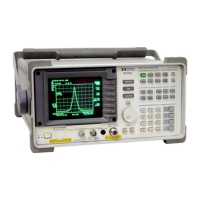3.
Making Basic Measurements
What You’ll Learn in This Chapter . . . . . . . . . . . . . . . . . . . . . .
Resolving Signals of Equal Amplitude Using the Resolution Bandwidth Function .
Resolving Small Signals Hidden by Large Signals Using the Resolution Bandwidth
Function . . . . . . . . . . . . . . . . . . . . . . . . . . . . . . . . .
Increasing the Frequency Readout Resolution Using the Marker Counter
. . . .
Decreasing the Frequency Span Using the Marker Track Function
. . . . . . .
Peaking Signal Amplitude with Preselector Peak . . . . . . . . . . . . . . . .
Tracking Unstable Signals Using Marker Track and the Maximum Hold and
Minimum Hold Functions . . . . . . . . . . . . . . . . . . . . . . . . .
Comparing Signals Using Delta Markers . . . . . . . . . . . . . . . . . . . .
Measuring Low-Level Signals Using Attenuation, Video Bandwidth, and Video
Averaging . . . . . . . . . . . . . . . . . . . . . . . . . . . . . . . .
Identifying Distortion Products Using the RF Attenuator and Traces
. . . . .
_
Distortion from the Analyzer . . . . . . . . . . . . . . . . . . . . . . . .
Third-Order Intermodulation Distortion . . . . . . . . . . . . . . . . . . .
Using the Analyzer As a Receiver in Zero Frequency Span . . . . . . . . . . .
Measuring Signals Near Band Boundaries Using Harmonic Lock . . . . . . . . .
3-l
3-2
3-4
3-6
3-7
3-8
3-9
3-12
3-15
3-20
3-20
3-22
3-24
3-26
4. Making Measurements
What You’ll Learn in This Chapter
......................
4-l
Measuring Amplitude Modulation with the Fast Fourier Transform Function
...
4-2
Stimulus-Response Measurements
.......................
4-7
What Are Stimulus-Response Measurements?
................
4-7
Using a Spectrum Analyzer with a Tracking Generator
............
4-8
Stepping through the Measurement
.....................
4-8
Tracking Generator Unleveled Condition
..................
4-12
Demodulating and Listening to an AM or FM Signal
..............
4-13
Triggering on a Selected Line of a Video Picture Field
.............
4-15
Making Reflection Calibration Measurements
.................
4-17
Reflection Calibration
...........................
4-17
Measuring the Return Loss
.........................
4-18
Using the Gate Utility to Simplify Time-Gated Measurements (Option 105 only)
.
4-19
Using the Time-Gated Spectrum Analyzer Capability Without the Gate Utility . .
4-22
Introducing the Time-Gated Spectrum Analyzer Capability ..........
4-22
Using the Time-Gated Spectrum Analyzer Capability to View Pulsed RF ....
4-24
Example of a Time-Gated Pulsed RF Signal
.................
4-26
Setting the Gate Delay and Gate Length Properly, When NOT Using the Gate
Utility
.................................
4-33
Using the Self-Calibration Routines with Option 105 .............
4-35
Performing a Functional Check of Option 105
................
4-36
Using the One Button Measurements to Measure N
dB
Bandwidth, Percent
Amplitude Modulation, and Third Order Intercept
(TOI)
...........
4-39
N
dB
Bandwidth Measurement
........................
4-39
Percent Amplitude Modulation Measurement
.................
4-40
Third Order Intermodulation Measurement
(TOI)
................
4-41
Using the Power Measurement Functions to make Transmitter Measurements . .
4-43
Occupied Bandwidth and Transmitter Frequency Error ............
4-43
Adjacent Channel Power Ratio (ACP)
....................
4-45
Channel Power Measurement
........................
4-48
Contents-2

